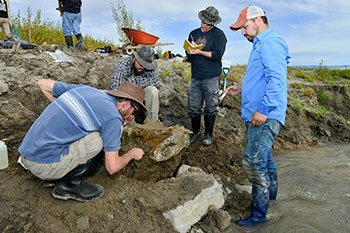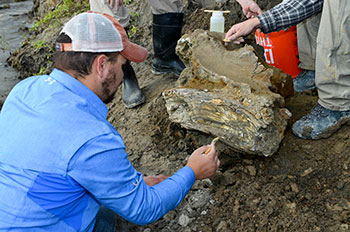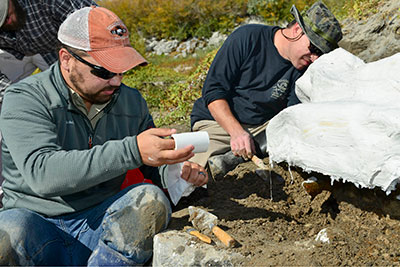Partial Mammoth Skull Recovered from American Falls Reservoir
Jenny Huang
11/13/2014
Transcript PDF 18 kb
 It’s not every day that an extinct elephant pokes its head out of the ground in Idaho; but Oct. 8 was one of those days. A retired U.S. Forest Service geologist who has been working as a volunteer for Reclamation to survey and monitor the shores of American Falls Reservoir for paleontological specimens (i.e., fossils), decided to visit an area he hadn’t been to before…and with a spectacular result.
It’s not every day that an extinct elephant pokes its head out of the ground in Idaho; but Oct. 8 was one of those days. A retired U.S. Forest Service geologist who has been working as a volunteer for Reclamation to survey and monitor the shores of American Falls Reservoir for paleontological specimens (i.e., fossils), decided to visit an area he hadn’t been to before…and with a spectacular result.
Lying partially submerged in the water were chunks of what looked like small petrified logs, but upon closer inspection were found to be tusk/mammoth tusk! And in the side of the bank that had developed as the channel eroded deeper and deeper into the shore was the source of the tusk – part of a mammoth skull. It was a find that needed immediate attention, not only because it was very large and needed to be professionally excavated and extracted, but also because its location (while above the low water line on that day) was several feet below the reservoir high water line. When irrigation stopped the following week, the reservoir level would begin to rise, and by the end of the month, the skull would be completely inundated and potentially lost.

American Falls Reservoir has long been known as a prime fossil area, and the annual fluctuation of the reservoir levels erodes more fossils out of the strata each year. The area is rich in Pleistocene era (i.e., the last ice age) vertebral specimens such as bison, ground sloth, saber-tooth cat, short-face bear, dire wolf and mammoth, indicating a much greener and lusher climate in the distant past. Since the reservoir was built, locals and visitors have collected these fossil bones and taken them home for personal collections. However, in 2009, the Paleontological Resources Preservation Act was passed which makes it illegal to Idaho State University Geology student Travis Helm brushes clean a mammoth skull discovered near American Falls Reservoir. The fossils were excavated and transferred from the site to the Idaho Museum of Natural History in Pocatello, Idaho.collect vertebrate fossils from Federal lands. Discovery of the mammoth fossil in American Falls Reservoir presented a great opportunity to educate the public on appropriate steps to take if they find something themselves.
The story was run locally in Idaho Falls, was picked up nationally via the Associated Press and CNN, and was also featured in international news outlets. Dr. Mary Thompson, the Principle Investigator for IMNH, gave a live interview on the mammoth skull excavation with Radio New Zealand. Listen to the interview >>

Idaho State University students Travis Helm and Jeff Castro apply plaster to a mammoth skull speciment discovered near American Falls Reservoir early last week. To protect the fossil it was encased in plaster and transferred from the site to the Idaho Museum of Natural History in Pocatello, Idaho on Octo. 18.Idaho State University (ISU) meticulously excavated the skull. Students carefully encased the fossil in a plaster jacket that hardened to enable its transport out from the site via army stretcher to the truck. The jacket was taken to IMNH and will be extracted, cleaned and preserved, potentially for exhibit. The tusk material was in remarkably good condition and is already on exhibit in the ‘When Giants Roamed’ section of the museum, located on the campus of ISU. It is possible that more parts of the mammoth are still buried in that shore so work is underway to formulate a plan to possibly use ground penetrating radar to gauge the presence of additional fossil bones. If more bones exist and it can be determined how much more dirt has to be moved to retrieve them—and secure the funding to do so—there could be a large-scale excavation during the next low-water season.

